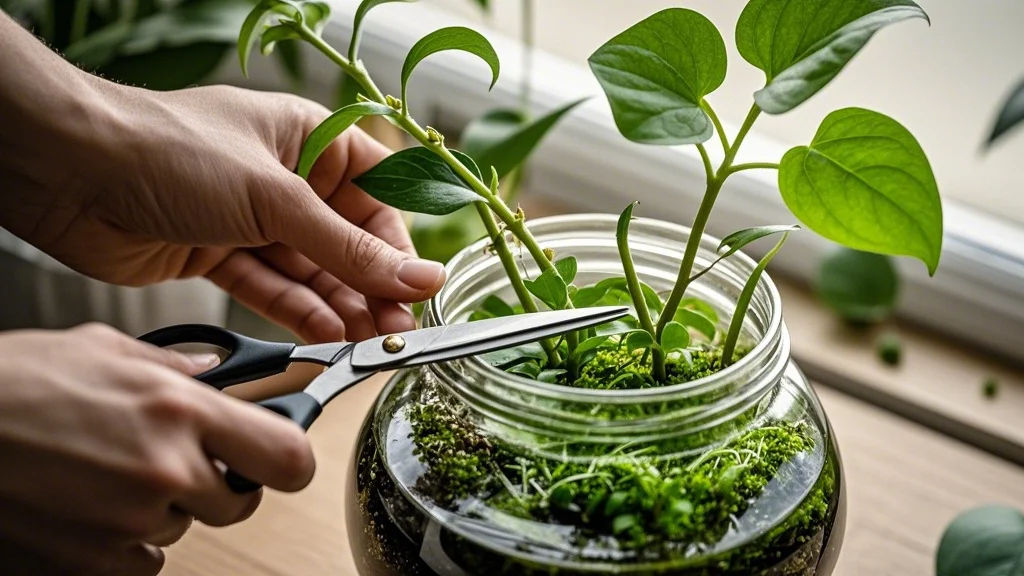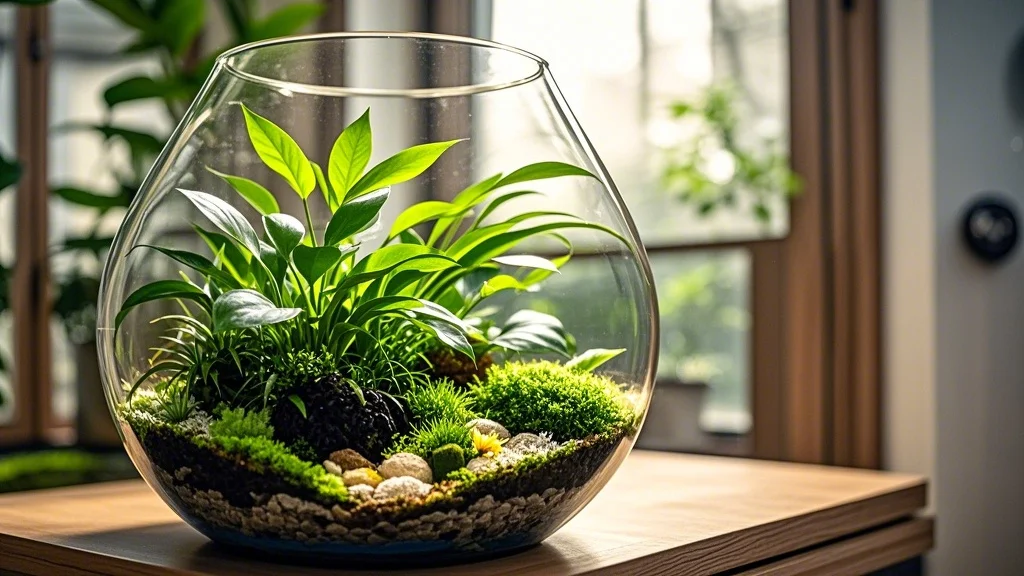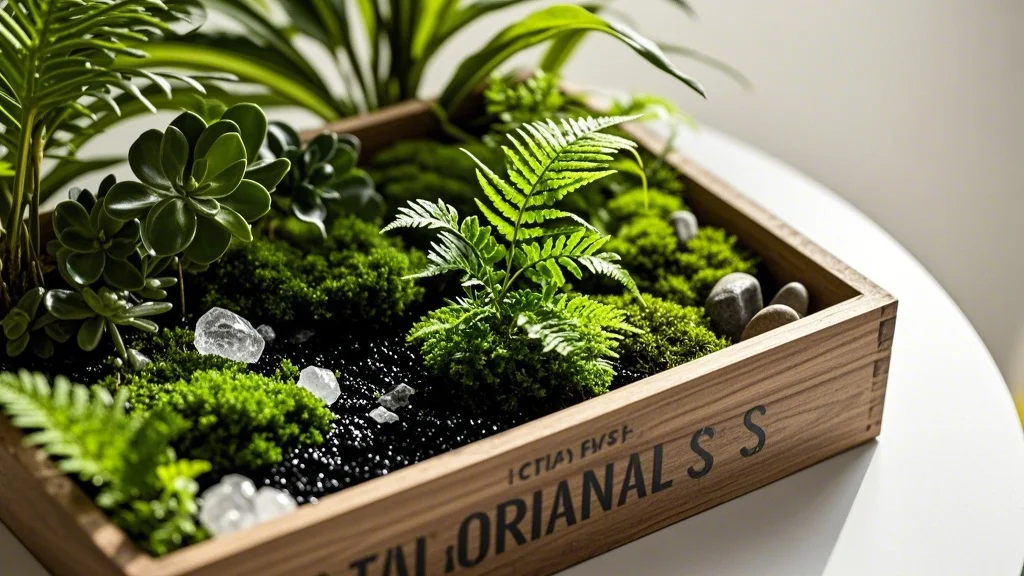Terrariums are miniature ecosystems enclosed in glass, offering a slice of nature in compact, low-maintenance form. While these self-contained gardens require less attention than traditional houseplants, they still need regular care to thrive. This comprehensive guide will walk you through a terrarium care schedule, ensuring your glass garden remains healthy and vibrant for years to come.
Contents
Weekly Care

1. Visual Inspection
- Examine plants for signs of disease or pests
- Check for any dead or yellowing leaves
- Observe overall plant growth and positioning
2. Light Management
- Rotate terrarium 1/4 turn for even light exposure
- Adjust position if plants show signs of light stress
3. Moisture Check
- Assess condensation levels on glass walls
- Touch soil surface to gauge moisture content
4. Pruning and Cleaning
- Remove any dead or decaying plant material
- Trim overgrown plants to maintain balance
- Wipe interior glass to maintain visibility
Monthly Care
1. Deep Cleaning
- Gently remove debris from soil surface
- Clean glass thoroughly inside and out
- Remove any algae growth with a soft brush
2. Soil Assessment
- Check for soil compaction
- Add small amounts of fresh substrate if needed
3. Fertilization (for open terrariums)
- Apply diluted, balanced liquid fertilizer sparingly
- Avoid fertilizing closed terrariums to prevent excess growth
4. Plant Health Evaluation
- Inspect root systems for signs of rot or overgrowth
- Check for pests hiding under leaves or in soil
Quarterly Care
1. Major Pruning
- Trim plants more aggressively to control size
- Remove any plants that have outgrown the space
2. Soil Rejuvenation
- Aerate soil gently with a small fork or chopstick
- Add thin layer of fresh substrate if needed
3. Hardscape Maintenance
- Clean decorative elements like rocks or driftwood
- Reposition hardscape items if desired
4. Humidity Assessment
- Evaluate overall moisture levels
- Adjust watering schedule if necessary
Seasonal Care
Spring
- Growth Boost
- Increase light exposure gradually
- Prune winter growth to encourage new shoots
- Pest Prevention
- Inspect closely for overwintering pests
- Apply organic pest control if needed
Summer
- Heat Management
- Move terrarium away from direct sunlight
- Increase ventilation for open terrariums
- Moisture Balance
- Monitor closely for signs of dehydration
- Mist more frequently if needed
Fall
- Light Adjustment
- Gradually decrease light exposure
- Consider supplemental grow lights if necessary
- Growth Slowdown
- Reduce fertilization (if applicable)
- Limit pruning to maintain energy reserves
Winter
- Humidity Control
- Monitor for excess condensation
- Increase ventilation if moisture builds up
- Temperature Management
- Keep terrariums away from cold drafts
- Maintain consistent room temperature
Specific Care for Different Terrarium Types
Closed Terrariums
Closed terrariums require minimal watering due to their self-sustaining nature. Focus on:
- Monitoring condensation levels
- Preventing algae growth
- Controlling plant size through regular pruning
Open Terrariums
Open terrariums need more frequent care:
- Regular watering to maintain moisture
- Fertilization every 4-6 months
- More frequent cleaning due to dust accumulation
Desert Terrariums
Terrariums with succulents and cacti have unique needs:
- Minimal watering (once every 2-4 weeks)
- High light requirements
- Well-draining, sandy soil
Tropical Terrariums
Moisture-loving plants require:
- High humidity maintenance
- Regular misting
- Careful monitoring for fungal issues
Troubleshooting Common Issues
1. Excessive Condensation
- Cause: Overwatering or poor ventilation
- Solution: Open lid temporarily, reduce watering frequency
2. Plant Yellowing
- Cause: Overwatering, poor drainage, or nutrient deficiency
- Solution: Adjust watering, improve drainage, or fertilize (open terrariums only)
3. Mold Growth
- Cause: Excess moisture and poor air circulation
- Solution: Remove affected areas, increase ventilation, reduce watering
4. Leggy Plant Growth
- Cause: Insufficient light
- Solution: Move to brighter location or add supplemental lighting
5. Pest Infestation
- Cause: Contaminated soil or plants, poor quarantine practices
- Solution: Isolate affected terrarium, treat with organic pesticides, remove severely infested plants
Tools and Supplies for Terrarium Maintenance
- Long-handled tweezers
- Small pruning scissors
- Soft brush for cleaning
- Spray bottle for misting
- Terrarium-specific fertilizer (for open systems)
- Activated charcoal for odor control
- Fresh, sterile substrate
- Isopropyl alcohol for tool sterilization
Best Practices for Long-Term Terrarium Health
- Quarantine new plants before adding to established terrariums
- Use sterilized tools to prevent disease spread
- Maintain consistent care routines
- Keep detailed records of maintenance activities
- Photograph terrariums regularly to track growth and changes
- Research specific needs of individual plant species
- Avoid overcrowding by starting with fewer, smaller plants
- Be patient – terrariums take time to establish and mature

Conclusion
Maintaining a healthy terrarium is a rewarding experience that allows you to nurture a miniature ecosystem. By following this comprehensive care schedule and adapting it to your specific terrarium type, you can ensure your glass garden remains a thriving, beautiful display of nature in miniature. Remember that each terrarium is unique, and as you become more familiar with your plants’ needs, you’ll develop an intuitive understanding of when and how to care for your miniature glass garden. With consistent attention and care, your terrarium will continue to flourish, providing a captivating slice of nature in your urban environment for years to come.







